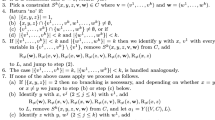Abstract
Most CSP algorithms are based on refinements and extensions of backtracking, and employ one of two simple “branching schemes”: 2-way branching or d-way branching, for domain size d. The schemes are not equivalent, but little is known about their relative power. Here we compare them in terms of how efficiently they can refute an unsatisfiable instance with optimal branching choices, by studying two variants of the resolution proof system, denoted C − RES and NG − RES, which model the reasoning of CSP algorithms. The tree-like restrictions, tree − C − RES and tree − NG − RES, exactly capture the power of backtracking with 2-way branching and d-way branching, respectively. We give a family instances which require exponential sized search trees for backtracking with d-way branching, but have size O(d 2 n) search trees for backtracking with 2-way branching. We also give a natural branching strategy with which backtracking with 2-way branching finds refutations of these instances in time O(d 2 n 2). The unrestricted variants of C − RES and NG − RES can simulate the reasoning of algorithms which incorporate learning and k-consistency enforcement. We show exponential separations between C − RES and NG − RES, as well as between the tree-like and unrestricted versions of each system. All separations given are nearly optimal.
Preview
Unable to display preview. Download preview PDF.
Similar content being viewed by others
References
Baker, A.B.: Intelligent Backtracking on Constraint Satisfaction Problems: Experimental and Theoretical Results. PhD thesis, University of Oregon (1995)
Beame, P., Kautz, H., Sabharwal, A.: Towards understanding and harnessing the potential of clause learning. Journal of Artificial Intelligence Research 22, 319–351 (2004)
Ben-Sasson, E., Impagliazzo, R., Wigderson, A.: Near-optimal separation of treelike and general resolution. Technical Report TR01-005, Electronic Colloquium on Computational Complexity (ECCC) (2000)
Bonet, M.L., Esteban, J.L., Galesi, N., Johansen, J.: Exponential separations between restricted resolution and cutting planes proof systems. In: Proc. of the 39th Annual IEEE Symposium on Foundations of Computer Science (FOCS 1998), pp. 638–647. IEEE Press, Los Alamitos (1998)
Bonet, M.L., Galesi, N.: A study of proof search algorithms for resolution and polynomial calculus. In: Proc. 40th Symposium on Foundations of Computer Science, pp. 422–432 (1999)
Buresh-Oppenheim, J., Mitchell, D., Pitassi, T.: Linear and negative resolution are weaker than resolution. Technical Report TR01-074, Electronic Colloquium on Computational Complexity (ECCC) (2001)
Celoni, J.R., Paul, W.J., Tarjan, R.E.: Space bounds for a game on graphs. Mathematical Systems Theory 10, 239–251 (1977)
Joey Hwang, C.Y.: A theoretical comparison of resolution proof systems for csp algorithms. Master’s thesis, Simon Fraser University (2004)
Krishnamurthy, B.: Short proofs for tricky formulas. Acta Informatica 22, 253–274 (1985)
Mitchell, D.G.: The Resolution Complexity of Constraint Satisfaction. PhD thesis, University of Toronto (2002)
Mitchell, D.G.: Resolution and constraint satisfaction. In: Rossi, F. (ed.) CP 2003. LNCS, vol. 2833, pp. 555–569. Springer, Heidelberg (2003)
Park, V.: An empirical study of different branching strategies for constraint satisfaction problems. Master’s thesis, University of Waterloo (2004)
Smith, B.M., Sturdy, P.: An empirical investigation of value ordering for finding all solutions. Presented at the ECAI 2004 workshop on Modelling and Solving Problems with Constraints (2004)
Stalmarck, G.: Short resolution proofs for a sequence of tricky formulas. Acta Informatica 33, 277–280 (1996)
Author information
Authors and Affiliations
Editor information
Editors and Affiliations
Rights and permissions
Copyright information
© 2005 Springer-Verlag Berlin Heidelberg
About this paper
Cite this paper
Hwang, J., Mitchell, D.G. (2005). 2 -Way vs.d -Way Branching for CSP. In: van Beek, P. (eds) Principles and Practice of Constraint Programming - CP 2005. CP 2005. Lecture Notes in Computer Science, vol 3709. Springer, Berlin, Heidelberg. https://doi.org/10.1007/11564751_27
Download citation
DOI: https://doi.org/10.1007/11564751_27
Publisher Name: Springer, Berlin, Heidelberg
Print ISBN: 978-3-540-29238-8
Online ISBN: 978-3-540-32050-0
eBook Packages: Computer ScienceComputer Science (R0)




